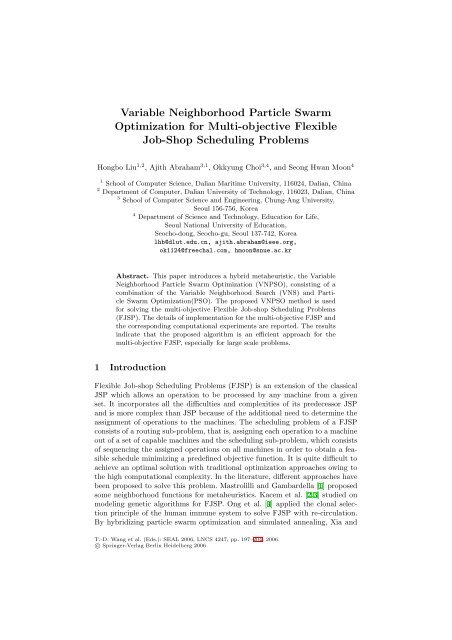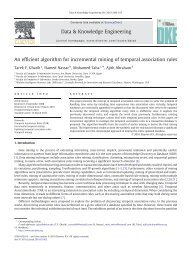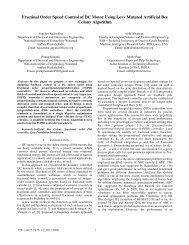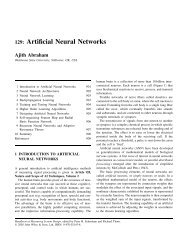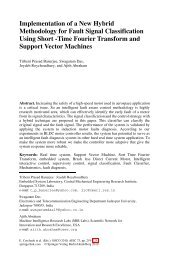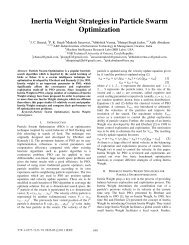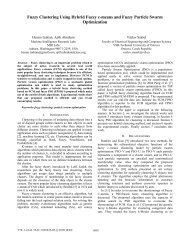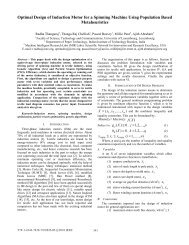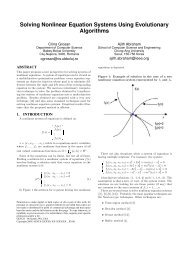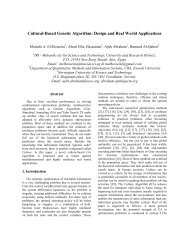Variable Neighborhood Particle Swarm Optimization ... - Ajith Abraham
Variable Neighborhood Particle Swarm Optimization ... - Ajith Abraham
Variable Neighborhood Particle Swarm Optimization ... - Ajith Abraham
Create successful ePaper yourself
Turn your PDF publications into a flip-book with our unique Google optimized e-Paper software.
<strong>Variable</strong> <strong>Neighborhood</strong> <strong>Particle</strong> <strong>Swarm</strong><br />
<strong>Optimization</strong> for Multi-objective Flexible<br />
Job-Shop Scheduling Problems<br />
Hongbo Liu 1,2 ,<strong>Ajith</strong><strong>Abraham</strong> 3,1 , Okkyung Choi 3,4 , and Seong Hwan Moon 4<br />
1 School of Computer Science, Dalian Maritime University, 116024, Dalian, China<br />
2 Department of Computer, Dalian University of Technology, 116023, Dalian, China<br />
3 School of Computer Science and Engineering, Chung-Ang University,<br />
Seoul 156-756, Korea<br />
4 Department of Science and Technology, Education for Life,<br />
Seoul National University of Education,<br />
Seocho-dong, Seocho-gu, Seoul 137-742, Korea<br />
lhb@dlut.edu.cn, ajith.abraham@ieee.org,<br />
ok1124@freechal.com, hmoon@snue.ac.kr<br />
Abstract. This paper introduces a hybrid metaheuristic, the <strong>Variable</strong><br />
<strong>Neighborhood</strong> <strong>Particle</strong> <strong>Swarm</strong> <strong>Optimization</strong> (VNPSO), consisting of a<br />
combination of the <strong>Variable</strong> <strong>Neighborhood</strong> Search (VNS) and <strong>Particle</strong><br />
<strong>Swarm</strong> <strong>Optimization</strong>(PSO). The proposed VNPSO method is used<br />
for solving the multi-objective Flexible Job-shop Scheduling Problems<br />
(FJSP). The details of implementation for the multi-objective FJSP and<br />
the corresponding computational experiments are reported. The results<br />
indicate that the proposed algorithm is an efficient approach for the<br />
multi-objective FJSP, especially for large scale problems.<br />
1 Introduction<br />
Flexible Job-shop Scheduling Problems (FJSP) is an extension of the classical<br />
JSP which allows an operation to be processed by any machine from a given<br />
set. It incorporates all the difficulties and complexities of its predecessor JSP<br />
and is more complex than JSP because of the additional need to determine the<br />
assignment of operations to the machines. The scheduling problem of a FJSP<br />
consists of a routing sub-problem, that is, assigning each operation to a machine<br />
out of a set of capable machines and the scheduling sub-problem, which consists<br />
of sequencing the assigned operations on all machines in order to obtain a feasible<br />
schedule minimizing a predefined objective function. It is quite difficult to<br />
achieve an optimal solution with traditional optimization approaches owing to<br />
the high computational complexity. In the literature, different approaches have<br />
been proposed to solve this problem. Mastrolilli and Gambardella [1] proposed<br />
some neighborhood functions for metaheuristics. Kacem et al. [2,3] studied on<br />
modeling genetic algorithms for FJSP. Ong et al. [4] applied the clonal selection<br />
principle of the human immune system to solve FJSP with re-circulation.<br />
By hybridizing particle swarm optimization and simulated annealing, Xia and<br />
T.-D. Wang et al. (Eds.): SEAL 2006, LNCS 4247, pp. 197–204, 2006.<br />
c○ Springer-Verlag Berlin Heidelberg 2006
198 H. Liu et al.<br />
Wu [5] developed an hybrid approach for the multi-objective flexible job-shop<br />
scheduling problem (FJSP). Because of the intractable nature of the problem<br />
and its importance in both fields of production management and combinatorial<br />
optimization, it is desirable to explore other avenues for developing good<br />
heuristic algorithms for the problem.<br />
<strong>Particle</strong> <strong>Swarm</strong> <strong>Optimization</strong> (PSO) incorporates swarming behaviors observed<br />
in flocks of birds, schools of fish, or swarms of bees, and even human<br />
social behavior, from which the intelligence is emerged [6]. It has become the<br />
new focus of research recently. However, its performance deteriorates as the<br />
dimensionality of the search space increases, especially for the multi-objective<br />
FJSP involving large scale. PSO often demonstrates faster convergence speed<br />
in the first phase of the search, and then slows down or even stops as the<br />
number of generations is increased. Once the algorithm slows down, it is difficult<br />
to achieve better scheduling solutions. To avoid termination at a local<br />
minimum, we introduce a novel hybrid meta-heuristic, the <strong>Variable</strong> <strong>Neighborhood</strong><br />
<strong>Particle</strong> <strong>Swarm</strong> <strong>Optimization</strong> (VNPSO) for the multi-objective FJSP.<br />
The basic idea is to drive those particles by a shaking strategy and get them<br />
to explore variable neighborhood spaces for the better scheduling solutions.<br />
2 Problem Formulation<br />
The classical FJSP considers in general the assignment of a set of machines<br />
M = {M 1 , ··· ,M m } toasetofjobsJ = {J 1 , ··· ,J n }, each of which consists<br />
of a set of operations J j = {O j,1 , ··· ,O j,p }. There are several constraints on<br />
the jobs and machines, such as (1) each machine can process only one operation<br />
at a time; (2) operations cannot be interrupted; (3) there are no precedence<br />
constraints among operations of different jobs; (4) setup times for the operations<br />
are sequence-independent and included in the processing times; (5) there is only<br />
one of each type of machine; (6) machines are available at any time.<br />
To formulate the objective, define C i,j,k (i ∈{1, 2, ··· ,m}, j ∈{1, 2, ··· ,n},<br />
k ∈ {1, 2, ··· ,p}) as the completion time that the machine M i finishes the<br />
operation O j,k ; ∑ C i represents the time that the machine M i completes the<br />
processing of all the jobs. Define C max = max{ ∑ C i } as the makespan, and<br />
C sum = ∑ m<br />
i=1 (∑ C i ) as the flowtime. The problem is thus to both determine<br />
an assignment and a sequence of the operations on all machines that minimize<br />
some criteria. Most important optimality criteria are to be minimized: (1) the<br />
maximum completion time (makespan): C max ; (2) the sum of the completion<br />
times (flowtime): C sum .<br />
Minimizing C sum asks the average job finishes quickly, at the expense of the<br />
largest job taking a long time, whereas minimizing C max ,asksthatnojobtakes<br />
too long, at the expense of most jobs taking a long time. Minimization of C max<br />
would result in maximization of C sum . The weighted aggregation is the most<br />
common approach to the problems. According to this approach, the objectives,<br />
F 1 = min{C max } and F 2 = min{C sum }, are summed to a weighted combination:
<strong>Variable</strong> <strong>Neighborhood</strong> <strong>Particle</strong> <strong>Swarm</strong> <strong>Optimization</strong> 199<br />
F = w 1 min{F 1 } + w 2 min{F 2 } (1)<br />
where w 1 and w 2 are non-negative weights, and w 1 + w 2 =1.Theseweights<br />
can be either fixed or adapt dynamically during the optimization. The dynamic<br />
weighted aggregation [7] was used in the paper. Alternatively, the weights can be<br />
changed gradually according to the Eqs. (2) and (3). The variation for different<br />
values of w 1 and w 2 (R = 200) are illustrated in Fig. 1.<br />
w 1 (t) =|sin(2πt/R)| (2)<br />
w 2 (t) =1− w 1 (t) (3)<br />
1<br />
0.8<br />
w1,w2<br />
0.6<br />
0.4<br />
0.2<br />
0<br />
0 200 400 600 800 1000<br />
Iteration<br />
Fig. 1. Dynamic weight variation<br />
3 The VNPSO Heuristic for FJSP<br />
The classical PSO model consists of a swarm of particles, which are initialized<br />
with a population of random candidate solutions. They move iteratively through<br />
the d-dimensional problem space to search the new solutions, where the fitness,<br />
f, can be calculated as the certain qualities measure. Each particle has a position<br />
represented by a position-vector x i (i is the index of the particle), and<br />
a velocity represented by a velocity-vector v i . Each particle remembers its own<br />
best position so far in a vector x # i ,anditsj-th dimensional value is x# ij .The<br />
best position-vector among the swarm so far is then stored in a vector x ∗ ,and<br />
its j-th dimensional value is x ∗ j . During the iteration time t, the update of the<br />
velocity from the previous velocity to the new velocity is determined by Eq.(4).<br />
The new position is then determined by the sum of the previous position and<br />
the new velocity by Eq.(5).<br />
v ij (t) =wv ij (t−1)+c 1 r 1 (x # ij (t−1)−x ij(t−1))+c 2 r 2 (x ∗ j (t−1)−x ij(t−1)) (4)<br />
x ij (t) =x ij (t − 1) + v ij (t) (5)
200 H. Liu et al.<br />
The particle swarm algorithm can be described generally as a population<br />
of vectors whose trajectories oscillate around a region which is defined by each<br />
individual’s previous best success and the success of some other particle. The best<br />
particle acts as an attractor, pulling its neighborhood particles towards it. Some<br />
previous studies has been shown that the trajectories of the particles oscillate<br />
in different sinusoidal waves and converge quickly [8]. During the iteration, the<br />
particle is attracted towards the location of the best fitness achieved so far by<br />
the particle itself and by the location of the best fitness achieved so far across<br />
the swarm. The algorithm has faster convergence. But very often for multimodal<br />
problems involving high dimensions it tends to suffer from premature<br />
convergence.<br />
<strong>Variable</strong> <strong>Neighborhood</strong> Search (VNS) is a relatively recent metaheuristic<br />
which relies on iteratively exploring neighborhoods of growing size to identify<br />
better local optima with shaking strategies [9,10]. More precisely, VNS escapes<br />
from the current local minimum x ∗ by initiating other local searches from starting<br />
points sampled from a neighborhood of x ∗ , which increases its size iteratively<br />
until a local minimum is better than the current one is found. These steps are<br />
repeated until a given termination condition is met. The metaheuristic method<br />
we propose, the VNPSO, was originally inspired by VNS. In PSO, if a particle’s<br />
velocity decreases to a threshold v c , a new velocity is assigned using Eq.(6):<br />
v ij (t) =wˆv + c 1 r 1 (x # ij (t − 1) − x ij(t − 1)) + c 2 r 2 (x ∗ j (t − 1) − x ij (t − 1)) (6)<br />
Algorithm 1. <strong>Variable</strong> <strong>Neighborhood</strong> <strong>Particle</strong> <strong>Swarm</strong> <strong>Optimization</strong> Algorithm<br />
01. Initialize the size of the particle swarm n, and other parameters.<br />
02. Initialize the positions and the velocities for all the particles randomly.<br />
03. Set the flag of iterations without improvement Nohope =0.<br />
04. While (the end criterion is not met) do<br />
05. t = t +1;<br />
06. Calculate the fitness value of each particle;<br />
07. x ∗ = argmin n i=1(f(x ∗ (t − 1)),f(x 1(t)),f(x 2(t)), ··· ,f(x i(t)), ··· ,f(x n(t)));<br />
08. If x ∗ is improved then Nohope =0,elseNohope = Nohope +1.<br />
09. For i= 1ton<br />
10. x # i (t) =argminn i=1(f(x # i<br />
(t − 1)),f(xi(t));<br />
11. For j =1tod<br />
12. If Nohope < 10 then<br />
13. Update the j-th dimension value of x i and v i<br />
14. according to Eqs.(4),(5)<br />
15. else<br />
16. Update the j-th dimension value of x i and v i<br />
17. according to Eqs.(7),(6).<br />
18. Next j<br />
19. Next i<br />
20. End While.
<strong>Variable</strong> <strong>Neighborhood</strong> <strong>Particle</strong> <strong>Swarm</strong> <strong>Optimization</strong> 201<br />
{<br />
v ij<br />
if |v ij |≥v c<br />
ˆv =<br />
(7)<br />
u(−1, 1)v max /ρ if |v ij |
202 H. Liu et al.<br />
35<br />
30<br />
MSPSO<br />
VTPSO<br />
VNPSO<br />
average(F)<br />
25<br />
20<br />
15<br />
0 0.5 1<br />
Iteration<br />
1.5 2<br />
x 10 4<br />
Fig. 3. The performance of the algoriths for (J10,O30,M10) FJSP<br />
44<br />
42<br />
40<br />
MSPSO<br />
VTPSO<br />
VNPSO<br />
average(F)<br />
38<br />
36<br />
34<br />
32<br />
30<br />
0 0.5 1<br />
Iteration<br />
1.5 2<br />
x 10 4<br />
Fig. 4. The performance of the algoriths for (J15,O56,M10) FJSP<br />
problem instances ((J8,O27,M8), (J10,O30,M10) and (J15,O56,M10) are<br />
taken from Kacem et al. [2,3]. In our experiments, the algorithms used for comparison<br />
were MSPSO (Multi-start PSO), VTPSO (Velocity Turbulent PSO) and<br />
VNPSO (<strong>Variable</strong> <strong>Neighborhood</strong> PSO). The parameters c 1 and c 2 were set to<br />
1.49 for all the PSO algorithms. Inertia weight w was decreased linearly from 0.9<br />
to 0.1. In VTPSO and VNPSO, ρ and v c were set to 2 and 1e-7 before 15,000<br />
iterations, while they were set to 5 and 1e-10 after 15,000 iterations. The swarm<br />
size in all the algorithms were set to 20. The average fitness values of the best<br />
solutions throughout the optimization run were recorded. The averages (F )and
<strong>Variable</strong> <strong>Neighborhood</strong> <strong>Particle</strong> <strong>Swarm</strong> <strong>Optimization</strong> 203<br />
Table 1. Comparing the results for FJSPs<br />
Instance Items MSPSO VTPSO VNPSO<br />
Best makespan 30 26 24<br />
Best flowtime 168 155 152<br />
(8, 27, 8) average 39.9087 28.3853 28.8000<br />
std ±5.7140 ±2.3146 ±3.8239<br />
time 184.0620 181.2500 181.2970<br />
Best makespan 19 13 11<br />
Best flowtime 96 92 75<br />
(10, 30, 10) average 19.4612 15.2000 15.0000<br />
std ±1.8096 ±1.3166 ±1.8257<br />
time 1.7145e+003 1.5891e+003 1.5908e+003<br />
Best makespan 36 30 29<br />
Best flowtime 231 241 220<br />
(15, 56, 10) average 37.2000 31.9000 30.8000<br />
std ±1.0328 ±1.2867 ±1.7512<br />
time 2.0497e+003 12.0816e+003 2.0703e+003<br />
the standard deviations (std) were calculated from the 10 different trials. The<br />
standard deviation indicates the differences in the results during the 10 different<br />
trials. Usually another emphasis will be to generate the schedules at a minimal<br />
amount of time. So the completion time for 10 trials were used as one of the criteria<br />
to improve their performance. Figs. 2, 3 and 4 illustrate the performance for<br />
the three algorithms during the search processes for the three FJSPs. Empirical<br />
results are illustrated in Table 1. In general, VNPSO performs better than the<br />
other two approaches, although its computational time is worse than VTPSO for<br />
the low dimension problem, (J8,O27,M8). VNPSO could be an ideal approach<br />
for solving the large scale problems when other algorithms failed to give a better<br />
solution.<br />
5 Conclusions<br />
In this paper, we introduce a hybrid metaheuristic, the <strong>Variable</strong> <strong>Neighborhood</strong> <strong>Particle</strong><br />
<strong>Swarm</strong> <strong>Optimization</strong> (VNPSO), consisting of a combination of the <strong>Variable</strong><br />
<strong>Neighborhood</strong> Search (VNS) and <strong>Particle</strong> <strong>Swarm</strong> <strong>Optimization</strong>(PSO), and considered<br />
its application for solving the multi-objective Flexible Job-shop Scheduling<br />
Problems (FJSP). The details of implementation for the multi-objective FJSP<br />
are provided and its performance was compared using computational experiments.<br />
The empirical results have shown that the proposed algorithm is an available and<br />
effective approach for the multi-objective FJSP, especially for large scale problems.<br />
Acknowledgments. This work was supported by the Korea Research Foundation<br />
Grant funded by the Korean Government (MOEHRD, Basic Research<br />
Promotion Fund) (KRF-2006-353-B00059).
204 H. Liu et al.<br />
References<br />
1. Mastrolilli M. and Gambardella L. M.: Effective neighborhood functions for the<br />
flexible job shop problem. Journal of Scheduling, (2002) 3(1):3-20.<br />
2. Kacem I., Hammadi S., and Borne P.: Approach by localization and multiobjective<br />
evolutionary optimization for flexible job-shop scheduling problems. IEEE Transactions<br />
on Systems, Man and Cybernetics, (2002) 32(1):1-13.<br />
3. Kacem I., Hammadi S. and Borne P.: Pareto-optimality approach for flexible jobshop<br />
scheduling problems: hybridization of evolutionary algorithms and fuzzy logic.<br />
Mathematics and Computers in Simulation, (2002) 60:245-276.<br />
4. Ong Z. X., Tay J. C. and Kwoh C. K.: Applying the Clonal Selection Principle<br />
to Find Flexible Job-Shop Schedules. in: Jacob C. et al. (eds.), ICARIS2005,<br />
LNCS3627, 2005, 442-455.<br />
5. Xia W. and Wu Z.: An effective hybrid optimization approach for multi-objective<br />
flexible job-shop scheduling problems. Computers and Industrial Engineering,<br />
(2005) 48:409-425.<br />
6. Kennedy J. and Eberhart R.: <strong>Swarm</strong> Intelligence. Morgan Kaufmann (2001).<br />
7. Parsopoulos K. E. and Vrahatis M. N.: Recent Approaches to Global <strong>Optimization</strong><br />
Problems through <strong>Particle</strong> <strong>Swarm</strong> <strong>Optimization</strong>, Natural Computing, (2002) 1:<br />
235-306.<br />
8. Cristian T. I.: The particle swarm optimization algorithm: convergence analysis<br />
and parameter selection. Information Processing Letters, (2003) 85(6):317-325.<br />
9. Hansen P. and Mladenović N.: <strong>Variable</strong> neighbourhood search: Principles and applications.<br />
European Journal of Operations Research, (2001) 130:449-467.<br />
10. Hansen P. and Mladenović N.: <strong>Variable</strong> neighbourhood search. In: Glover F. W.<br />
and Kochenberger G. A. (eds.), Handbook of Metaheuristics, Dordrecht, Kluwer<br />
Academic Publishers (2003).<br />
11. Liu H. and <strong>Abraham</strong> A.: Fuzzy Adaptive Turbulent <strong>Particle</strong> <strong>Swarm</strong> <strong>Optimization</strong>,<br />
in: Proceedings of the Fifth International conference on Hybrid Intelligent Systems,<br />
(2005) 445-450.


